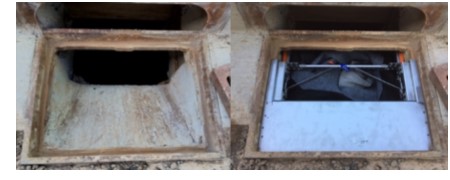- Home
- Who We Are
- Advocacy
- Stormwater Basics
- BMP Maintenance
- BMP Systems
- BMP Fact Sheets
- BMP Suppliers
- Biofiltration Soils
- Catch Basin Insert
- Construction Site BMP
- Debris Separator
- BMP Maintenance Suppliers
- Flow Restrictor and Regulator
- Hydrodynamic Separator
- Modular Dentention and Retention Systems
- Oil Water Separator
- Permeable Pavers and Permeable Asphalt Products
- Pretreatment Devices
- Rain Water Harvesting
- Spill Control and Containment Systems
- Stormwater Filtration System
- Stormwater Trash Debris Netting
- Tree Box Filter
- Stormwater Science
Post Construction Inlet FiltersPost Construction Inlet Filters (Drop inlet protection), are an easy to install stormwater BMP. They are normally custom configured to fit the specific drainage structure that is being treated. Since they are custom manufactured, it is possible for inlet filters to be installed in new construction or manufactured to fit into already existing basins / contaminated areas (retrofit). Inlet filters are capable of treating a wide range of pollutants from the litter / leaves to fine sediment, grit, and oils. Post Construction Inlet Filters are typically comprised of a corrosion resistant steel frame (stainless steel, aluminum, fiberglass, etc.) and a geotextile sediment bag attached to the frame. The sediment bag hands suspended from the rigid frame at a distance below the grate. Between the framing and filter bag there are gaps in the framing that allow water to bypass through the filter without being treated if the filter bag is already filled with water or debris. The filter bag can be made from different materials to facilitate the capture of different pollutants. A mesh type material is used when leaves / larger debris and trash is the primary targeted pollutant. If larger sediment and trash is targeted a fine mesh woven / woven monofilament fabric can be used (40 micron opening size). Finally, to treat hydrocarbons and fine sediments, recycled polyester felt (100-150 micron) is layered on top of the woven monofilament fabric. In addition to the filter bag materials it is possible to add different materials in the bottom of the bag to treat additional hydrocarbons and heavy metals. To install an in let filter remove the grate from the casting or concrete drainage structure. Clean the ledge (lip) of the casting from or drainage structure to ensure it is free of stone and dirt. Drop in the inlet filter through the clear opening and be sure the suspension hangers rest firmly on the inside ledge (lip) of the casting. Replace the grate and confirm it is elevated no more than 1/8 inch, the thickness of the support frame. The frequency of maintenance will vary depending on the application, area of installation (relative to grade and runoff exposure), and the time of year relative to the geographic location (infrequent rain, year round rain, rain and snow conditions). In general, a biannual cleaning should be scheduled in order to ensure the filters are capable of treating large storm events. Filters can be maintained by hand or a vacuum truck depending on the size of the filters being cleaned. If sediment is caked onto the filter bag a hose can be used to reverse flush the sediment from the filter bag. Inlet filters allow for decentralized treatment of storm water from a large run off area. The variable filter medias allow a wide variety of particulates to be targeted and captured. The bypass feature prevents inlets from backing up and causing localized flooding. Since the devices are installed beneath the frame and grate they have minimal impact on the immediate area, and require no additional construction burden. Although they are easily installed inlet filters do have a few drawbacks. Due to their decentralized nature there can be numerous devices on one site. When cleaning it can be difficult to locate all filters and ensure they are properly maintained by a property manager. Filter bags can tear due to excessive load or be compromised by cigarette butts. In these instances the filter must be removed from the inlet and the filter bag replaced. Overall, inlet filters provide a low cost easy and easy-to-install method for controlling a variety of different contaminants. They have been shown to be effective in new construction and retrofit type applications. References:
Providers:Suppliers of Post Construction Inlet Filters
|


